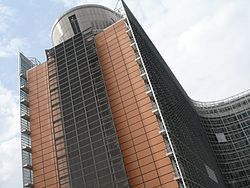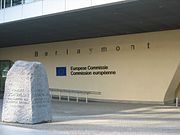Berlaymont building
From Wikipedia, the free encyclopedia
| Berlaymont building | |
 The Berlaymont building in Brussels, housing the European Commission |
|
| Building | |
|---|---|
| Type | European Commission headquarters |
| Location | Brussels, Belgium |
| Construction | |
| Completed | 1969 |
| Floor Count | 14 |
| Floor Area | 240,500 m² |
| Design Team | |
| Architect | Lucien De Vestel |
The Berlaymont building is an important governmental building in Brussels, Belgium. It houses the European Commission headquarters.
The structure is located at Rue de la Loi/Wetstraat in what is known as the "European district", where it is one of the most prominent of the buildings housing EU and international institutions.
Contents |
[edit] History
The plot of land on which the building was constructed was originally occupied by the convent of the Dames du Berlaymont. They managed an important girls’ school. In the 1960s, to anchor the European presence in Brussels, the Belgian government bought the plot, and the Dames du Berlaymont moved to Waterloo.
The building was built from 1963 to 1969 and became the symbol of the European presence in Brussels. It housed 3,000 Commission civil servants from 1967 to 1991, when it was decided that a complete renovation was necessary and that asbestos protecting the steel structure had to be removed. The refurbishment lasted over a decade, the Commission had moved out to the Breydel building for that period. There was considerable criticism of time and cost over-runs of the project.
In 2004, the Commission returned to the building. As of 2005, all members of the Barroso Commission and their cabinets (private offices) are based in the Berlaymont. The office of the President of the European Commission and the Commission boardroom are on the 13th floor, together with the meeting room of the Hebdo and the resturante La Convivialité. The Secretariat General, Legal Service and other central services of the Commission are also based in the building.
[edit] Architecture
Architect Lucien De Vestel designed the original building, with input from Jean Gilson, Jean Polak and André Polak. It consists of a cross-shaped tower, with 13 floors, situated on a wide basement, four floors high. The tower has a star shape—with four wings radiating out from a central hub. The floors of the wings are supported by a steel structure hanged to pretensioned beams placed on the top of a narrow reinforced concrete structure.
The building has 240,000 m² of floor space on 18 levels, connected by 42 lifts and 12 escalators. Offices for 3,000 officials and meeting rooms are in the tower. Restaurant and services, a 900 seat cafeteria, TV studio, conference rooms, storage rooms, Nordic sauna, car parking for over 1,100 vehicles and various services occupy the basement.
Architects Pierre Lallemand, Steven Beckers and Wilfried Van Campenhout carried out the 1991-2004 Renovation which was originally intended to be finished by 1997. Modifications included the addition of a meeting room on the top of the south-east wing, the construction of a complete structure with three meeting rooms constructed on the north-east side of the grounds and large openings in the ground floor to allow natural light distribution in the basement. Around the exterior there is a double façade with movable Venetian blinds to keep the building temperature down in the summer, one of many environmentally friendly features making it one of the most environmentally sound public buildings in Europe.
[edit] In popular culture
- The building briefly appeared in the 2006 film, "Children of Men", shown along with buildings in other cities that had been subject to attacks.
- Berlaymont appears in the sequel to NRK's drama mini-series "Kodenavn Hunter".
[edit] See also
- Location of European Union institutions
- Brussels and the European Union
- Charlemagne building, another Commission building next door
- Madou Plaza Tower, another Commission building in Brussels
- Justus Lipsius building, of the Council of the European Union
- Espace Léopold, the Parliament building in Brussels
[edit] External links
- Photographs of the Berlaymont building
- Berlaymonster - blog from the building
- After 13 years of hold-ups and incompetence, the EU's 'Berlaymonster' rises like a phoenix The Independent





